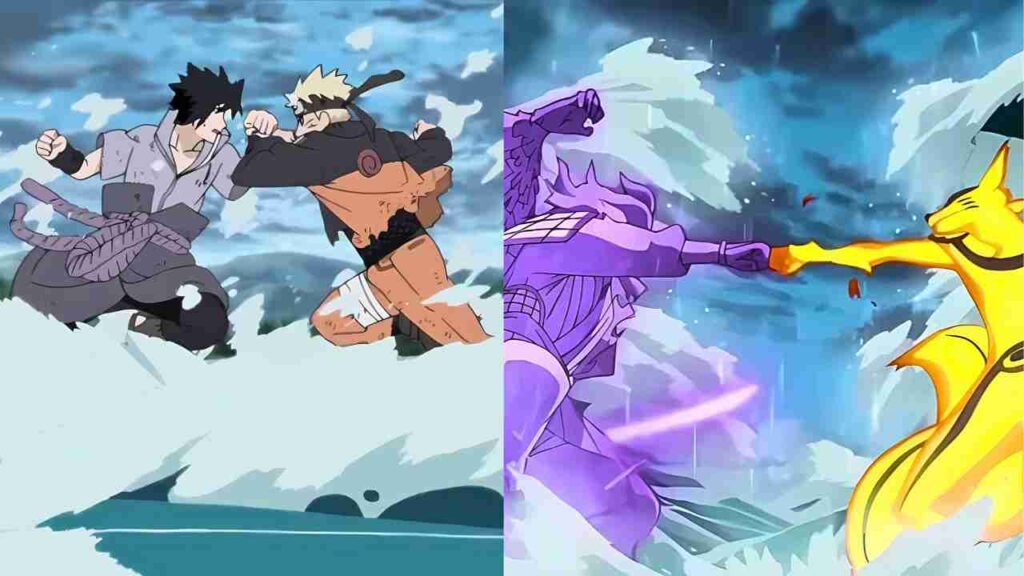
A Battle of Ideals
The battle between Naruto and Sasuke in the Valley of the End shows the difference in their beliefs and how those beliefs shape their actions. Naruto stands for hope, the power of connections, and never giving up, even when facing tough times. He has lived alone for most of his life and now values the friendships he has made, fighting to protect and hold onto them.
Sasuke, on the other hand, views relationships as something that holds him back from getting revenge on his brother, Itachi. He believes that to achieve his goal, he needs to cut ties with others and focus solely on gaining power.
The clash between Naruto and Sasuke goes beyond just their personal differences and touches on deeper, universal questions. It asks whether true strength comes from the connections we make with others, or if it’s found in being alone and focusing on our own goals. It also explores whether relationships can heal the pain from the past or if they just get in the way of moving forward.
The Legacy of the Valley
The Valley of the End is more than just a physical place, it symbolizes the repeating cycle of conflict and the weight of past legacies. The statues of Hashirama Senju and Madara Uchiha remind us of their own fight as former friends turned enemies, similar to Naruto and Sasuke’s struggle. This connection shows how history tends to repeat itself, with each new generation carrying the unresolved issues and conflicts from the past.
By setting their fight in the Valley of the End, Naruto shows how hard it is to escape the cycles of hate and revenge passed down through generations. The valley stands quietly, witnessing the hopes and failures of the past battles, and now, it’s the place where Naruto and Sasuke must decide whether to repeat the mistakes of history or rise above them. This setting highlights the challenge of breaking free from the past while also showing the possibility of changing the future.
Unleashing Their Powers

Naruto and Sasuke’s battle at the Valley of the End is a powerful showcase of how far they’ve come in terms of their skills and abilities. Naruto’s Rasengan, represents the bond he shares with Jiraiya and the hard work he’s put in. On the other hand, Sasuke’s Chidori reflects his darker path and the influence of the Curse Mark, showing his embrace of power that comes at a cost.
The fight between Naruto and Sasuke is not only a physical battle but also an emotional one. As they unleash their powerful techniques, every move reflects their past and the different paths they’ve chosen. The back-and-forth between Naruto’s Rasengan and Sasuke’s Chidori builds the tension, making each strike feel more significant. When their attacks collide, it creates a huge crater in the valley, leaving a physical mark that symbolizes the emotional scars both characters carry.
Moments of Reflection
In the middle of the intense battle, flashbacks remind viewers of the bond Naruto and Sasuke once shared. These flashbacks take us back to their early days as members of Team 7, where teamwork and common dreams brought them together. These memories serve as a sharp contrast to their current fight, highlighting the deep emotional rift between them now. The flashbacks make the battle even more emotional, showing how far they’ve fallen from their once-strong friendship.
These flashback moments highlight the emotional contrast between what Naruto and Sasuke once had and what they’ve become. The flashbacks also show what’s really at stake. For Naruto, the battle is about saving his “brother” and holding onto their bond, while for Sasuke, it’s about cutting ties in order to achieve his own personal goals.
A Symbolic Stalemate

The outcome of the battle between Naruto and Sasuke leaves a lasting effect, as neither of them truly wins. Sasuke decides to leave, turning down Naruto’s request to return to Konoha. However, he doesn’t deliver a final, fatal blow, showing that, deep down, he still has some attachment to Naruto that he can’t fully ignore.
For Naruto, despite his best efforts, he fails to bring Sasuke back, which marks his first real failure. This failure becomes a turning point for him, pushing him to grow and evolve further on his journey.
The physical scars from their battle, such as Naruto’s scratched forehead protector, represent the deep and lasting effects of their conflict. These marks aren’t just signs of their intense fight, they also symbolize the emotional wounds that linger between them. The protector, once a symbol of Naruto’s bond with his village, now reflects the fracture in his relationship with Sasuke.
This unresolved tension sets up their eventual rematch in Naruto: Shippuden, where their differing ideals and unresolved issues continue to drive their actions and decisions. The battle in the Valley of the End doesn’t just mark a physical confrontation but also serves as a key moment that shapes their futures and ongoing struggles.
Conclusion
This iconic battle is remembered not just for its action but for the emotional depth and character development it delivered. It defined the overarching narrative of Naruto, shaping both Naruto’s journey as a hero and Sasuke’s as a complex anti-hero.
The Valley of the End is more than just a place of battle—it’s a central point in the story of Naruto, symbolizing key themes such as the power of bonds, the difficulty of choosing one’s own path, and the emotional weight of both friendship and rivalry. This fight is a memorable moment in anime history because it shows the clash of two characters with different ideals and backgrounds.

